#10th century bce
Text

Painted wooden coffin of the priest of Amun Amenemope
* Thebes
* 950-900 BCE
* British Museum
London, July 2022
71 notes
·
View notes
Text
youtube
Da Ke Ding, September 23, 2016
Da Ke Ding, c. 1046 - 771 B.C.E. (late Western Zhou dynasty, China), bronze, 93.1 cm high (Shanghai Museum) Speakers: Dr. Kristen Chiem and Dr. Beth Harris. Created by Beth Harris and Steven Zucker.
Smarthistory
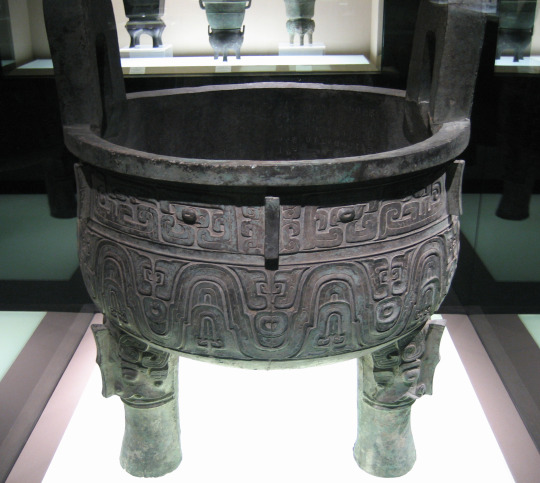
Da Ke ding (大克鼎), Western Zhou (1046–771 BC), China
Bronze
Height 93.1 centimetre (36.7 in); width 75.6 centimetre (29.8 in) (bore),
74.9-centimetre (29.5 in) (inside diameter); weight 201.5 kilogram (444 lb)
Discovered in Famen Town, Fufeng County, Shaanxi in 1890.
Collection of the Shanghai Museum
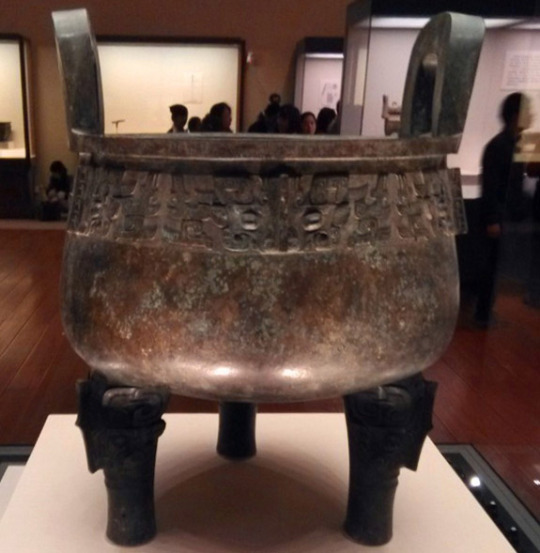
Da Yu ding (大盂鼎), early 10th century BC
Western Zhou (1046–771 BC), China
Bronze
Height 101.9 cm (40.1 in), width 77.8 cm (30.6 in), weight 153.5 kg (338 lb)
Discovered in Li Village, Jingdang Township, Qishan County, Shaanxi in 1849.
Collection of the National Museum of China


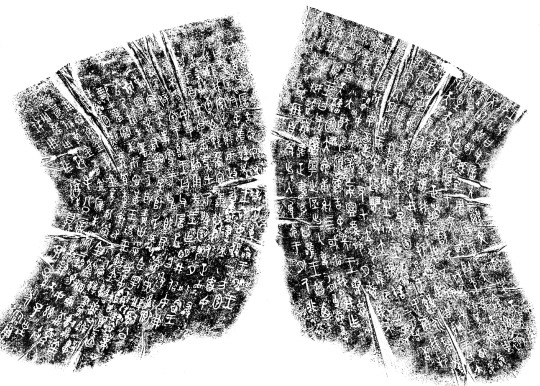
Mao Gong ding (毛公鼎), 857-828 BC
Late Western Zhou (1046–771 BC), China
Bronze
Height: 53.8 cm, depth of belly: 27.2 cm, diameter: 47 cm, weight: 34.7 kg
Discovered in Qishan County, Shaanxi in 1843.
This "ting" cauldron has a wide, flared mouth, a linked ring motif decorating the rim, upright handles, and three hoofed feet. The inscription, which can be divided into seven sections, describes how when King Xuan of Zhou came to the throne, he was anxious to see the country thrive, and charged his uncle, the Duke of Mao, with governing the domestic and external affairs of state, big and small, and to do so conscientiously and selflessly. The inscription goes on to state that the King then presented the Duke with official vestments and gifts, and that this vessel was cast in order to record the honor given to the Duke for his descendants.
Collection of the National Palace Museum, Taipei
#Western Zhou dynasty#Zhou dynasty#Chinese#art#art history#1st millennium bce#9th century bce#10th century bce#metal#bronze#language#taotie#pattern#design#archaeology#national palace museum#national museum of china#shanghai museum
3 notes
·
View notes
Text

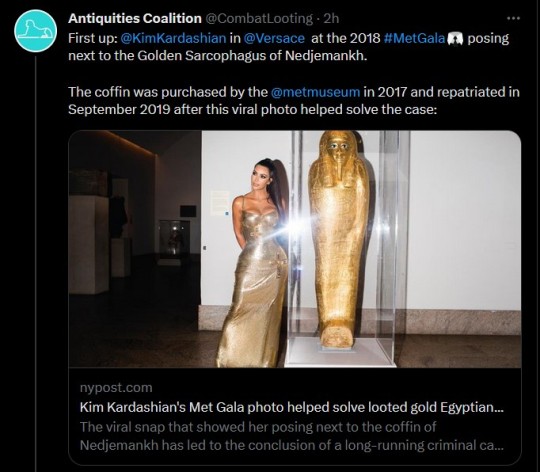
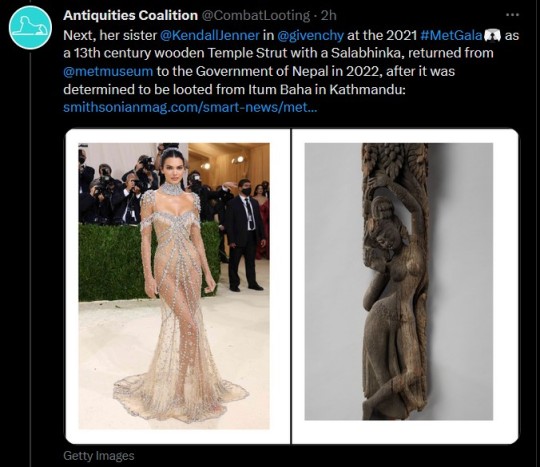
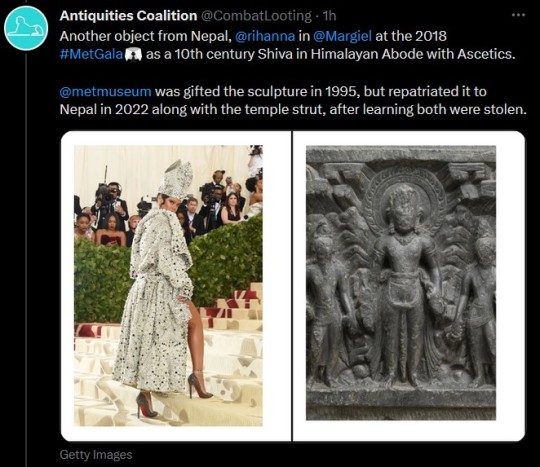

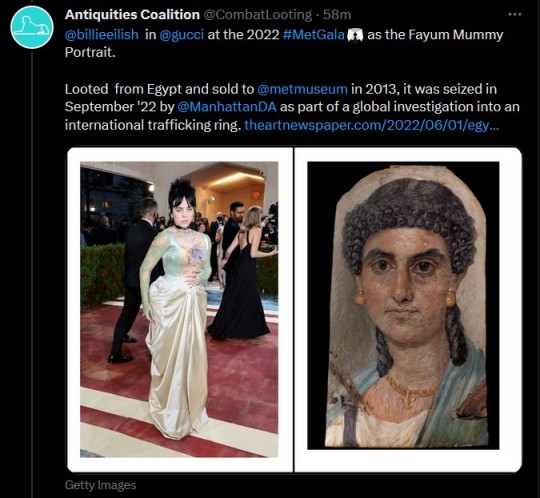
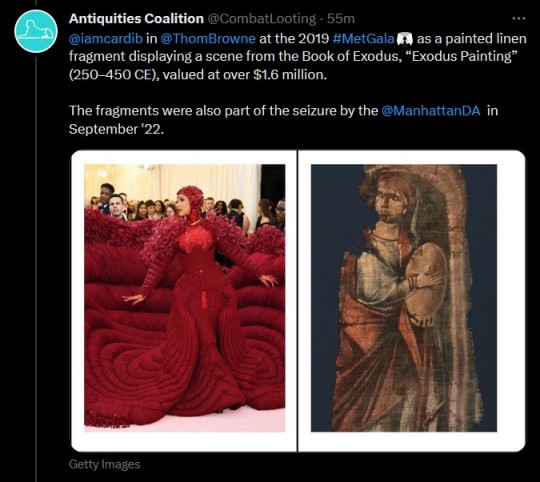
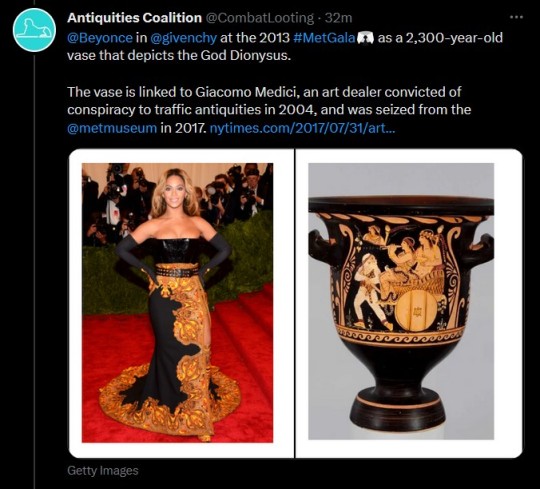
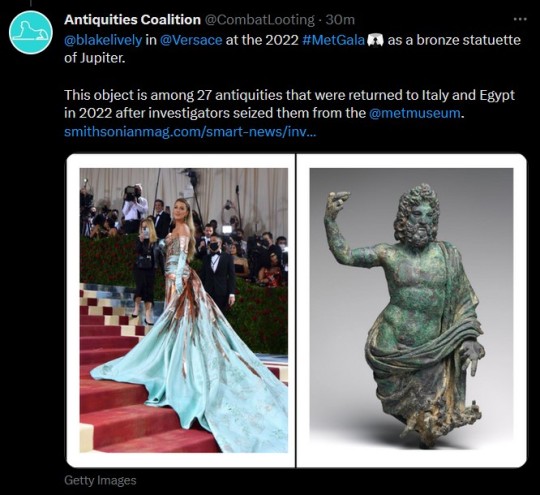
Looks vs. Loot at the Metropolitan Museum of Art by The Antiquities Coalition (@/CombatLooting) on Twitter
Transcription below the cut
1: The #MetGala may be "fashion's biggest night," but tonight's event hides some dark truths at @/metmuseum...including a long history of looted antiquities. To spotlight some of the contested objects from the Met's collection, we are featuring #MetGala vs. Loot [THREAD]
2. First up: @/KimKardashian in @/Versace at the 2018 #MetGala posing next to the Golden Sarcophagus of Nedjemankh. The coffin was purchased by @/metmuseum in 2017 and repatriated in 2019 after this viral photo helped solve the case. (link)
3. Next, her sister @/KendallJenner in @/givenchy at the 2021 #MetGala as the 13th century wooden Temple Strut with Salabhinka, returned from @/metmuseum to the Government of Nepal in 2022, after it was determined to be looked from Itum Baha in Kathmandu. (link)
4. Another object from Nepal, @/rihanna in @/Margiel at the 2018 #MetGala as a 10th century Shiva in Himalayan Adobe with Ascetics. @/metmuseum was gifted the sculpture in 1995, but repatriated it to Nepal in 2022 along with the temple strut, after learning both were stolen.
5. Dakota Johnson in @/gucci at the 2022 #MetGala as a terracotta kylix (c. 470 bCE). This piece, valued at $1.5 million, was seized from the @/metmuseum in July 2022 after being linked to Italian antiquities trafficker Gianfranco Becchina. (link)
6. @/billieeilish in @/gucci at the 2022 #MetGala as the Fayum Mummy Portrait. Looted from Egypt and sold to @/metmuseum in 2013, it was seized in September '22 by @/ManhattanDA as part of a global investigation into an international trafficking ring. (link)
7. @/iamcardib in @/ThomeBrowne at the 2019 #MetGala as a painted linen fragment displaying a scene from the Book of Exodus, 'Exodus Painting" (250-450 CE), valued at over $1.6 million. The fragments were also part of the seizure by the @/ManhattanDA in September '22.
8. @/Beyonce in @/givenchy at the 2013 #MetGala as a 2,300-year-old vase that depicts the god Dionysus. The vase is linked to Giacomo Medici, an art dealer convicted of conspiracy to traffic antiquities in 2004, and was seized from the @/metmuseum in 2017. (link)
9. @/blakelively in @/Versace at the 2022 #MetGala as a bronze statuette of Jupiter. This object is among 27 antiquities that were returned to Italy and Egypt in 2022 after investigators seized them from the @/metmuseum. (link)
5K notes
·
View notes
Text

Orthostat Relief: Lion-Hunt Scene
Syria, Hittite, 10th−9th century BCE
219 notes
·
View notes
Note
wtf even is hermeticism? I heard of a comic book that showcases hermeticism, and it turns out it was mostly cabala and some stuff about higher dimensions, and the fuzzy line between stories and reality.
The thing about the fuzzy line between stories and reality cropped up in a youtuber's analysis of a different comic book series that revolved around hermeticism, like empowering yourself by telling a story.
Is it like, tricking reality into being a different way by acting on the basis of the Nous?? Is that how Hermes Trismegistus became a god, by ascending to and becoming one with the Nous/Monad/whatever?
If he never existed, the stories about him created him, on the basis of the Nous?
Hermetica is a body of ancient texts attributed to Legendary Sage Hermes Trismegistus. They're extremely difficult to date, and you see guesses anywhere from the 4th century BCE to the 4th century CE.
Hermeticism is quite eclectic. It exists as a blend of Greek, Egyptian, and Jewish, and other north-African mythologies and philosophies all rolled into one. The important thing to remember, is that Trismegistus is portrayed as being the source of all wisdom ever forever. All knowledge came from him. Everything cool or interesting about Egyptian, Greek, or Jewish theology is supposed to be his doing.
Hermeticism is a blend of several different religious currents that would be difficult to summarize in a tumblr post, but Hermetic doctrine is honestly less important than HOW Hermeticism syncretizes these disparate currents into a single theology. Its VERY good at sniffing out similarities between theologies, and gluing them together. Additionally, it really likes math. Hermeticism is really good at using math and science to reinforce its mythology.
So when people say "Hermetic" they generally mean one of three things:
1 - Classical Hermetica, as in the ancient body of work attributed to Hermes Trismegistus.
2 - Renaissance Hermetica. The theology was lost for a hot minute, and reintroduced to Europe in the 15th century via a weird Italian named Ludovico Lazzarelli. This was the first guy to identify as a "Hermetic Christian." (There were also some Islamic mystics around the 8th-10th century who really liked Hermetica, but they're oddballs even by the standards of Islamic mystics. #isma-ilimoment)
3 - "Neo-Hermeticism" This is the version of Hermetica that came back in the 17th-18th century. This is where you got folks like the Hermetic Order of the Golden Dawn, who rediscovered just how good Hermetic theology was as a conceptual mortar. They just went hog-wild with it. That's where you get "Hermetic Quabbala." Europe at the time had just seen an explosion of interest in ancient Egypt, and thats why a lot of Quabbalistic texts have a bunch of Egyptian stuff.
So the stuff about higher dimensions and the lines between reality and fiction? That sounds like 1970s Chaos Magic, which itself was highly influenced by Hermetica, specifically Neo-Hermeticism.
As for the nature of Trismegistus himself, even classical Hermetica has like nine different backstories for him. Depending on the text, hes Hermes, Thoth, a combination of Hermes and Thoth, a normal sage who was very wise, a man who achieved godhood, the tutor of Moses, etc, etc. There's no set mythology for Trismegistus beyond "Legendary Sage of Sages."
I'm gonna plug my patreon here because I'm writing about Trismegistus in an alchemical context on Patreon right now.
337 notes
·
View notes
Note
Hi! I have a question, what type of ink did the scribes use? I'm wondering what base it has, and how did it evolve with time and the eventual switch to paper. Thank you! I hope you have a great day
An ochre based ink. Composition depends on the colour ink the scribe was using. Since the most common are red and black:
Red ink was an ochre pellet that when water was applied it provided ink. This ink had a base of iron, lead, phosphorous, and sulphur. Most of this comes from the natural ochre being used, that was then mixed with gum arabic and suspended with either water or animal fat.
Black ink was a pellet, just as the red ink, with a base of lead, phosphorous, and sulphur. Most of this comes from the soot used to make it and then it was mixed in the same way as red ink. It's a novel lead-carbon ink as most typically were in the early periods.
I cannot tell you how it evolved with time as the data set for that is extremely limited. We do not have that many pallets and it is difficult to assess it on papyri without delicate techniques. It is also very far from my area of expertise, so I'm not comfortable providing any information on any perceived compositional change in ink from 4000 BCE - 500 CE. 4500 years is a long time to track a compositional change in a limited data set. That being said; the Egyptians were creatures of habit and since, unlike today, they tended to only change something if it was required I can imagine the formula did not differ all that much.
Paper didn't arrive in Egypt until the 10th Century CE, which is quite far removed from Ancient Egypt and thus irrelevant.
(It should be noted that the study linked above only uses 12 fragments from the Roman period and thus cannot be considered indicative of the entirety of Egyptian history)
If the hard science is too complex for you, here's the Smithsonian summing up the findings in a more digestible manner.
73 notes
·
View notes
Text
Scrying, A History And Guide To One Of The World's Oldest Practices ~ by W.S
Scrying is a subcategory in the Art of Divination, in its simplest form, scrying is gazing into the surface of an object and allowing the mind to wander, opening oneself up to the other side allowing images and words into your brain from an external non-physical source. Basically Hallucinating Without the use of Drugs.

Scrying Throughout The Ages
Babylonia
Scrying has been practiced for thousands of years. Our modern history holds Babylonia as the earliest written record of the practice, they put water in bowls alongside droplets of oil. This process was known as lecanomancy a subcategory of hydromancy, and the scryers would read the shapes the oil made within the water to divine possible futures or speak with the dead. The practice spread and later it became more common to simply use water as it was a naturally reflective surface.
Hebrew Bible
The Hebrew Bible Briefly Goes over an object which is supposedly used for scrying in Chapter 44 of The Book Of Genesis. A silver chalice is placed inside Benjamin's Sack to frame him for theft. In his trial, it is stated that the chalice is used for divination, but in the Book Of Genesis, it is never expressly stated he actually did any Divination.
Ancient Persia
The Ancient Persian Epic The Shahnameh, from the 10th Century, details a mystical object known as The Cup Of Jamshid, which was said to be used by ancient Persian kings to Observe the "Seven Layers Of The Universe". The Cup Of Jamshid is said to have been first used in Persepolis, which existed from 518-330 BCE.
John Dee and Sir Edward Kelley
In 1582, John Dee sought the guidance of one of the most famous scryers of the time Sir. Edward Kelley. It was through his teachings that John Dee was able to crack the code of proper visualization and begin to transcribe what he believed to be the voices of angels. They guided him to create Angelical or as it's known today, Enochian.
Scrying and its modern-day PreConceptions
Scrying has garnered much popularity in Hollywood's portrayal of witches, in the TV Show Charmed, witches use scrying to find lost objects or the location of Demons. In Supernatural it allows for a witch to see things from a great distance away. And while yes it is true that one can hone these skills to a degree of supernatural clarity, I would be lying if I said it was as Visually stunning in real life.
The Reality is in the Modern Era, Scrying allows one to commune with the spirits of their ancestors and commune with the other side just as it has always been. And with those trained in the art of divination, one can read the past and future of a person or kingdom. The theatrics of modern television paint scrying as a showcase of our abilities, but to the uninitiated when they see someone scrying, they are often unprepared for how dull it is. When a person is scrying and is in a trance, their eyes go dead as they allow their mind to wander. These trance states are what allow one to see past the veil and into the supernatural realm. But to external viewers, it is rather boring, to say the least. This is why you won't often see a practitioner scrying in front of people who haven't the foggiest idea of its nuances.
Simple Scrying Ritual For Communing With Ancestral Spirits By W.S
To begin scrying safely one must understand the dangers, you are preparing to go into the world of the supernatural, the things you see can see you as well and you must be aware that they can leave a permanent scar on your psyche if abused in any manner. Go into it with wards up and confidence in your abilities.
This scrying ritual is used to commune with the spirits of one's own ancestors and when done properly can allow you to have conversations and get advice from them.
Opus Est
Patience
Candle
Dark Room
Mirror
Sacred Water
Oil
Salt
Before anything, one must prep the mirror for communing with the Ancestral Spirits, To do this mix together one part water, salt, and oil into a slurry. Dipping the left ring finger into the mixture begin drawing the pentacle in each corner of the mirror, connecting each pentacle with a line following the edge of the mirror as shown below

As you are drawing on the pentacles, feel free to use the below chant, but you may change it to your liking so long as the main goals are the same.
" Lock This Mirror, Lock It Tight, Lock it now with sacred light. Let only those whom I call, Answer Me to give me guidance. May no evil enter through this portal, and may no unnamed spirit answer my calls. As I have said it so it has always been."
The mirror is now prepped for the ritual, the next step is to create a salt circle where you are going to be seated. As well as a secondary salt circle surrounding the candle and mirror. These salt circles are an extra step of protection between yourself and the spiritual realm.
The next step is to darken the room, as dark as possible, pitch black is best. From there, place the candle in front of the mirror and ignite it, then begin the process of staring into the mirror. Watch as the candle shifts shadows around and brings new shapes to the surface.

After about 10-30 minutes your body will begin to go into a trance state of mind, from there you can call upon the name of one of your ancestors to help guide you. It may not be immediate as scrying takes years to master but after a few tries you should begin to see their faces and hear their voice.
Scrying sessions can be anywhere from a few minutes, to several hours or even days from some accounts. Don't be frustrated if nothing happens your first time. And most importantly, always remember to thank the spirits for their time and energy, and always remember to say goodbye when you blow out the candle.
After each use feel free to cleanse the mirror with sacred water and store the mirror in a sacred space.
Post Script
Scrying isn't for everyone and that's okay. It takes patience and an open mind, but if you decide to give it a try it can do wonders for your spiritual practice.I hope I was able to teach you something new, Until next time my Friends :)
Thank you for sitting down and having Tea with me on the Other side of the Great Divide
☕ Like My Blog? Then consider buying me a Ko-Fi ☕

#occult#occultism#occultist#demons#ars goetia#solomonic magick#magick#witchcraft#folklore#folklorist#magi#magus#grimoire#grimoires#witch#witchblr#witches#witchythings#witchlife#pagan witch#alchemist#enochian#WanderingSorcerer#scrying#ancestors#ancestral#ghosts#divination
208 notes
·
View notes
Text
I keep seeing a post going around saying that people should stop using the “colonized” names for cities in Israel/Palestine and should instead use the Arabic names.
I need you guys to be so for real right now, Hebrew is quite literally the indigenous language of the area. Like believe what you want about Israel, but Hebrew objectively and factually originated in that land. The earliest record of written Hebrew is the Khirbet Qeiyafa inscription, found near Beit Shemesh which dates back to the 11th-10th century BCE.
The first record of the name Jerusalem is in the Egyptian Execration Texts which date back to the 20th century BCE.
Arabic was introduced to the land in the 7th century CE. The first recorded use of “Al-Quds” was in the 9th century CE.
I could do this for every single ancient city in the land. Bethlehem, Hebron, Jericho, Jaffa, Beer Sheva, Acre, and Ashkelon all existed prior to the Arab conquests in the 7th century CE and the introduction of Arabic to the land.
The fact that we use the Hebrew names of these cities isn’t some conspiracy to make them sound “more Jewish”, the modern Hebrew names are direct descendants of the ancient Canaanite words for these places. Hebrew is the only surviving Canaanite language.
Believe what you want about Israel, but claiming that the Hebrew names for these cities are “colonial” names is a disgusting erasure of Jewish history in the land.
#israel#jews#jewish#hebrew#arabic#israel palestine conflict#palestine#I have a feeling I’m gonna get hate for this but honestly I had to say something#y’all are willingly spreading pan-Arabist propaganda
100 notes
·
View notes
Text
Origins of the Pibo: Let’s take a trip along the Silk Road.
1. Introduction to the garment:
Pibo 披帛 refers to a very thin and long shawl worn by women in ancient East Asia approximately between the 5th to 13th centuries CE. Pibo is a modern name and its historical counterpart was pei 帔. But I’ll use pibo as to not confuse it with Ming dynasty’s xiapei 霞帔 and a much shorter shawl worn in ancient times also called pei.
Below is a ceramic representation of the popular pibo.
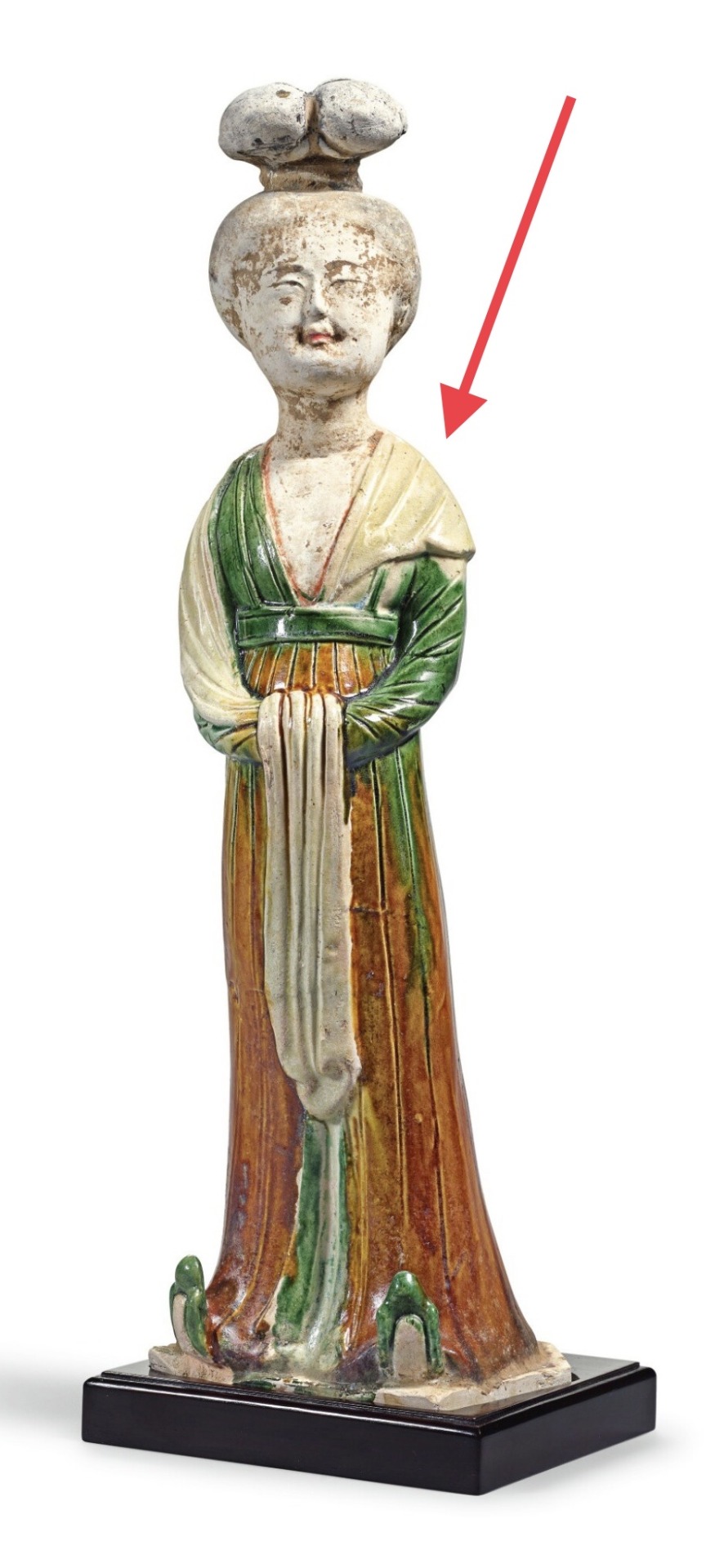
A sancai-glazed figure of a court lady, Tang Dynasty (618–690, 705–907 CE) from the Sze Yuan Tang Collection. Artist unknown. Sotheby’s [image source].
Although some internet sources claim that pibo in China can be traced as far back as the Qin (221-206 BCE) or Han (202 BCE–9 CE; 25–220 CE) dynasties, we don’t start seeing it be depicted as we know it today until the Northern and Southern dynasties period (420-589 CE). This has led to scholars placing pibo’s introduction to East Asia until after Buddhism was introduced in China. Despite the earliest art representations of the long scarf-like shawl coming from the Northern and Southern Dynasties period, the pibo reached its popularity apex in the Tang Dynasty (618–690 CE: 705–907 CE).
Academic consensus: Introduction via the Silk Road.
The definitive academic consensus is that pibo evolved from the dajin 搭巾 (a long and thin scarf) worn by Buddhist icons introduced to China via the Silk Road from West Asia.
披帛是通过丝绸之路传入中国的西亚文化, 与中国服饰发展的内因相结合而流行开来的一种"时世妆" 的形式. 沿丝绸之路所发现的披帛, 反映了丝绸贸易的活跃.
[Trans] Pibo (a long piece of cloth covering the back of the shoulders) was a popular female fashion period accessory introduced to China by West Asian cultures by way of the Silk Road and the development of Chinese costumes. The brocade scarves found along the Silk Road reflect the prosperity of the silk trade that flourished in China's past (Lu & Xu, 2015).
I want to add to the above theory my own speculation that, what the Chinese considered to be dajin, was most likely an ancient Indian garment called uttariya उत्तरीय.
2. Personal conjecture: Uttariya as a tentative origin to pibo.
In India, since Vedic times (1500-500 BCE), we see mentions in records describing women and men wearing a thin scarf-like garment called “uttariya”. It is a precursor of the now famous sari. Although the most famous depiction of uttariya is when it is wrapped around the left arm in a loop, we do have other representations where it is draped over the shoulders and cubital area (reverse of the elbow).
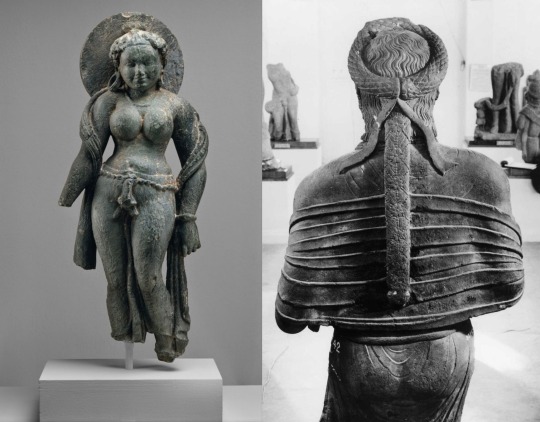
Left: Hindu sculpture “Mother Goddess (Matrika)”, mid 6th century CE, gray schist. Artist unknown. Looted from Rajasthan (Tanesara), India. Photo credit to Metropolitan Museum of Art, New York, United States [image source].
Right: Rear view of female statue possibly representing Kambojika, the Chief Queen of Mahakshatrapa Rajula, ca. 1st century CE. Artist unknown. Found in the Saptarishi Mound, Mathura, India. Government Museum, Mathura [image source].
Buddhism takes many elements from Hindu mythology, including apsaras अप्सरा (water nymphs) and gandharvas गन्धर्व (celestial musicians). The former was translated as feitian 飞天 in China. Hindu deities were depicted wearing clothes similar to what Indian people wore, among which we find uttariya, often portrayed in carvings and sculptures of flying and dancing apsaras or gods to show dynamic movement. Nevertheless, uttariya long predated Buddhism and Hinduism.
Below are carved representation of Indian apsaras and gandharvas. Notice how the uttariya are used.

Upper left: Carved relief of flying celestials (Apsara and Gandharva) in the Chalukyan style, 7th century CE, Chalukyan Dynasty (543-753 CE). Artist Unknown. Aihole, Karnataka, India. National Museum, New Delhi, India [image source]. The Chalukyan art style was very influential in early Chinese Buddhist art.
Upper right: Carved relief of flying celestials (gandharvas) from the 10th to the 12th centuries CE. Artist unknown. Karnataka, India. National Museum, New Delhi, India [image source].
Bottom: A Viyadhara (wisdom-holder; demi-god) couple, ca. 525 CE. Artist unknown. Photo taken by Nomu420 on May 10, 2014. Sondani, Mandsaur, India [image source].
Below are some of the earliest representations of flying apsaras found in the Mogao Caves, Gansu Province, China. An important pilgrimage site along the Silk Road where East and West met.
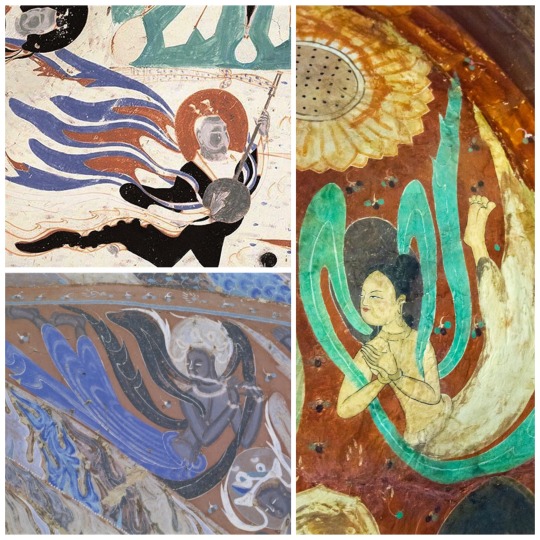
Left to right: Cave No. 461, detail of mural in the roof of the cave depicting either a flying apsara or a celestial musician. Western Wei dynasty (535–556 CE). Artist unknown. Mogao Grottoes, Dunhuang, China [image source].
Cave 285 flying apsara (feitian) in one of the Mogao Caves. Western Wei Dynasty (535–556 CE), Artist unknown. Photo taken by Keren Su for Getty Images. Mogao Grottoes, Dunhuang, China [image source].
Cave 249. Mural painting of feitian playing a flute, Western Wei Dynasty (535-556 CE). Image courtesy by Wang Kefen from The Complete Collection of Dunhuang Grottoes, Vol. 17, Paintings of Dance, The Commercial Press, Hong Kong, 2001, p. 15. Mogao Grottoes, Dunhuang, China [image source].
I theorize that it is likely that the pibo was introduced to China via Buddhism and Buddhist iconography that depicted apsaras (feitian) and other deites wearing uttariya and translated it to dajin.
3. Trickle down fashion: Buddhism’s journey to the East.
However, since Buddhism and its Indian-based fashion spread to West Asia first, to Sassanian Persians and Sogdians, it is likely that, by the time it reached the Han Chinese in the first century CE, it came with Persian and Sogdian influence. Persians’ fashion during the Sassanian Empire (224–651 CE) was influenced by Greeks (hellenization) who also had a a thin long scarf-like garment called an epliblema ἐπίβλημα, often depicted in amphora (vases) of Greek theater scenes and sculptures of deities.

Left to right: Dame Baillehache from Attica, Greece. 3rd century BCE, Hellenistic period (323-30 BCE), terracotta statuette. Photo taken by Hervé Lewandowski. Louvre Museum, Paris, France [image source].
Deatail view of amphora depicting the goddess Artemis by Athenian vase painter, Andokides, ca. 525 BCE, terracotta. Found in Vulci, Italy. Altes Museum, Berlin, Germany [image source].
Statue of a Kore (young girl), ca. 570 BCE, Archaic Period (700-480 BCE), marble. Artist unknown. Uncovered from Attica, Greece. Acropolis Museum, Athens, Greece [image source].
Detail view of Panathenaic (Olympic Games) prize amphora with lid, 363–362 BCE, Attributed to the Painter of the Wedding Procession and signed by Nikodemos, terracotta. Uncovered from Athens, Greece. J. Paul Getty Museum, Los Angeles, California, United States [image source].
Roman statue depicting Euterpe, muse of lyric poetry and music, ca. 2nd century CE, marble, Artist unknown. From the Villa of G. Cassius Longinus near Tivoli, Italy. Photo taken by Egisto Sani on March 12, 2012, Vatican Museums, Rome, Italy [image source].
Greek (or Italic) tomb mural painting from the Tomb of the Diver, ca. 470 BCE, fresco. Artist unknown. Photo taken by Floriano Rescigno. Necropolis of Paestum, Italy [image source].
Below are Iranian and Iraqi period representations of this long thin scarf.

Left to right: Closeup of ewer likely depicting a female dancer from the Sasanian Period (224–651 CE) in ancient Persia , Iran, 6th-7th century CE, silver and gilt. Artist unknown. Mary Harrsch. July 10, 2015. Arthur M. Sackler Gallery of Asian Art, Smithsonian, Washington D.C [image source].
Ewer with nude dancer probably representing a maenad, companion of Dionysus from the Sasanian Period (224–651 CE) in ancient Persia, Iran, 6th-7th century CE, silver and gilt. Artist unknown. Mary Harrsch. July 16, 2015. Arthur M. Sackler Gallery of Asian Art, Smithsonian, Washington D.C [image source].
Painting reconstructing the image of unveiled female dancers depicted in a fresco, Early Abbasid period (750-1258 CE), about 836-839 CE from Jawsaq al-Khaqani, Samarra, Iraq. Museum of Turkish and Islamic Art, Istanbul [image source].
The earliest depictions of Buddha in China, were very similar to West Asian depictions. Ever wonder why Buddha wears a long draped robe similar to a Greek himation (Romans called it toga)?
Take a look below at how much the Greeks influenced the Kushans in their art and fashion. The top left image is one of the earliest depictions of Buddha in China. Note the similarities between it and the Gandhara Buddha on the right.
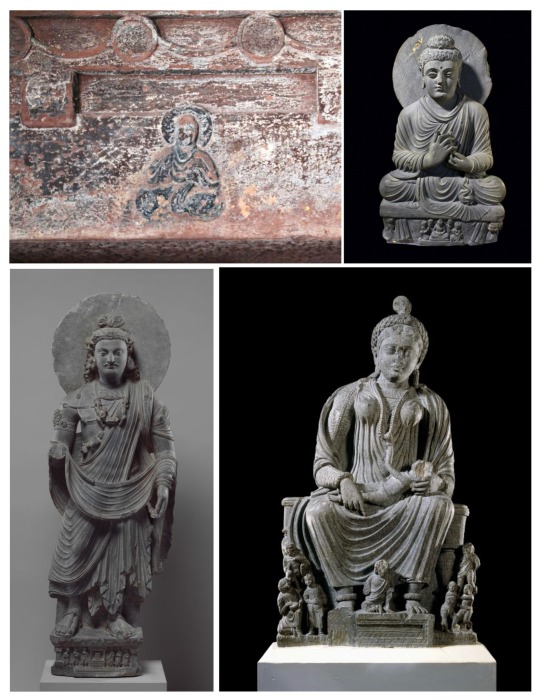
Left: Seated Buddha, Mahao Cliff Tomb, Sichuan Province, Eastern Han Dynasty, late 2nd century C.E. (photo: Gary Todd, CC0).
Right: Seated Buddha from Gandhara, Pakistan c. 2nd–3rd century C.E., Gandhara, schist (© Trustees of the British Museum)
Standing Bodhisattva Maitreya (Buddha of the Future), ca. 3rd century, gray schist. From Gandhara, Pakistan. Image credit to The Metropolitan Museum of Art, New York City, United States [image source].
Statue of seated goddess Hariti with children, ca. 2nd to 3rd centuries CE, schist. Artist unknown. From Gandhara, Pakistan. The British Museum, London, England [image source].
Before Buddhism spread outside of Northern India (birthplace), Indians never portrayed Buddha in human form.
Early Buddhist art is aniconic, meaning the Buddha is not represented in human form. Instead, Buddha is represented using symbols, such as the Bodhi tree (where he attained enlightenment), a wheel (symbolic of Dharma or the Wheel of Law), and a parasol (symbolic of the Buddha’s royal background), just to name a few. […] One of the earliest images [of Buddha in China] is a carving of a seated Buddha wearing a Gandharan-style robe discovered in a tomb dated to the late 2nd century C.E. (Eastern Han) in Sichuan province. Ancient Gandhara (located in present-day Afghanistan, Pakistan, and northwest India) was a major center for the production of Buddhist sculpture under Kushan patronage. The Kushans occupied portions of present-day Afghanistan, Pakistan, and North India from the 1st through the 3rd centuries and were the first to depict the Buddha in human form. Gandharan sculpture combined local Greco-Roman styles with Indian and steppe influences (Chaffin, 2022).
In the Mogao Caves, which contain some of the earliest Buddhist mural paintings in China, we see how initial Chinese Buddhist art depicted Indian fashion as opposed to the later hanfu-inspired garments.

Left to right: Cave 285, detail of wall painting, Western Wei dynasty (535–556 CE). Mogao Grottoes, Dunhuang, China. Courtesy the Dunhuang Academy [image source]. Note the clothes the man is wearing. It looks very similar to a lungi (a long men’s skirt).
Photo of Indian man sitting next to closed store wearing shirt, scarf, lungi and slippers. Paul Prescott. February 20, 2015. Varanasi, India [image source].
Cave 285, mural depiction of worshipping bodhisattvas, 6th century CE, Wei Dynasty (535-556 A.D.), Unknown artist. Mogao Grottoes, Dunhuang, China. Notice the half bow on his hips. That is a common style of tying patka (also known as pataka; cloth sashes) that we see throughout Indian history. Many of early Chinese Buddhist paintings feature it, including the ones at Mogao Caves.
Indian relief of Ashoka wearing dhoti and patka, ca. 1st century BC, Unknown artist. From the Amaravathi village, Guntur district, Andhra Pradesh, India. Currently at the Guimet Museum, Paris [image source].
Cave 263. Mural showing underlying painting, Northern Wei Dynasty (386–535 CE). Artist Unknown. Picture taken November 29, 2011, Mogao Grottoes, Dunhuang, China [image source]. Note the pants that look to be dhoti.
Comparison photo of modern dhoti advertisement from Etsy [image source].
Spread of Buddhism to East Asia.

Map depicting the spread of Buddhism from Northern India to the rest of Asia. Gunawan Kartapranata. January 31, 2014 [image source]. Note how Mahayana Buddhism arrived to China after passing through Kushan, Bactrean, and nomadic steppe lands, absorbing elements of each culture along the way.
Wealthy Buddhist female patrons emulated the fantasy fashion worn by apsaras, specifically, the uttariya/dajin and adopted it as an everyday component of their fashion.

Cave 285. feitian mural painting on the west wall, Western Wei Dynasty (535–556 CE). Artist unknown. Mogao Grottoes, Dunhuang, China [image source].
Cave 285. Detail view of offering bodhisattvas (bodhisattvas making offers to Buddha) next to the phoenix chariot on the Western wall of the cave. Western Wei Dynasty (535–556 CE). Artist unknown. Mogao Grottoes, Dunhuang, China [image source].
Cave 61 Khotanese (from the kingdom of Khotan 于阗 [56–1006 CE]) donor ladies, ca. 10th century CE, Five Dynasties period (907 to 979 CE). Artist unknown. Picture scanned from Zhang Weiwen’s Les oeuvres remarquables de l'art de Dunhuang, 2007, p. 128. Uploaded to Wikimedia Commons on October 11, 2012 by Ismoon. Mogao Grottoes, Dunhuang, China [image source].
Detail view of Ladies Adorning Their Hair with Flowers 簪花仕女图, late 8th to early 9th century CE, handscroll, ink and color on silk, Zhou Fang 周昉 (730-800 AD). Liaoning Provincial Museum, Shenyang, China [image source].
Therefore, the theory I propose of how the pibo entered East Asia is:
India —> Greek influenced West Asia (Sassanian Persians, Sogdians, Kushans, etc…) —> Han China —> Rest of East Asia (Three Kingdoms Korea, Asuka Japan, etc…)
Thus, the most likely theory, in my person opinion, is Buddhist iconography depicting uttariya encountered Greek-influenced West Asian Persian, Sogdian, and Kushan shawls, which combined arrived to China but wouldn’t become commonplace there until the explosion in popularity of Buddhism from the periods of Northern and Southern Dynasties to Song.
References:
盧秀文; 徐會貞. 《披帛與絲路文化交流》 [The brocade scarf and the cultural exchanges along the Silk Road]. 敦煌研究 (中國: 敦煌研究編輯部). 2015-06: 22 – 29. ISSN 1000-4106.
#hanfu#chinese culture#chinese history#buddhism#persian#sogdian#kushan#gandhara#indian fashion#uttariya#pibo#history#asian culture#asian art#asian history#asian fashion#east asia#south asia#india#pakistan#iraq#afghanistan#sassanian#silk road#fashion history#tang dynasty#eastern han dynasty#cultural exchange#greek fashion#mogao caves
283 notes
·
View notes
Text


This is a message to my black brothers and sisters
Learn about your history
Ethiopia is one of the oldest countries in Africa; the emergence of Ethiopian civilization dates back thousands of years. Abyssinia or rather "Ze Etiyopia" was ruled by the Semitic Abyssinians (Habesha) composed mainly of the Amhara and Tigray, the Cushitic Agaw. In the Eastern escarpment of the Ethiopian highlands and more so the lowlands was the home of the Arab-descended Harari that founded Sultanates such as Ifat and Adal and the Afars. In the central and south were found the ancient Sidama and Semitic Gurage, among otheres. One of the first kingdoms to rise to power in the territory was the kingdom of D'mt in the 10th century BC, which established its capital at Yeha. In the first century AD the Aksumite Kingdom rose to power in the modern Tigray Region with its capital at Aksum and grew into a major power on the Red Sea, subjugating South Arabia and Meroe and its surrounding areas. In the early fourth century, during the reign of Ezana, Christianity was declared the state religion. Ezana's reign is also when the Aksumites first identified themselves as "Ethiopians", and not long after, Philostorgius became the first foreign author to call the Aksumites Ethiopians.[The Aksumite empire fell into decline with the rise of Islam in the Arabian peninsula, which slowly shifted trade away from the Christian Aksum.[citation needed] It eventually became isolated, its economy slumped and Aksum's commercial domination of the region ended.The Aksumites gave way to the Zagwe dynasty, who established a new capital at Lalibela before giving way to the Solomonic dynasty in the 13th century. During the early Solomonic period, Ethiopia went through military reforms and imperial expansion that allowed it to dominate the Horn of Africa.
How did Ethiopia Resist Imperialism?
Ethiopia, formerly Abyssinia, is one of the world’s oldest countries. Dating to around 400 BCE, the region is documented in the in the King James Version of the Bible as the Kingdom of Axum. Along with Rome, Persia, and China, Axum was considered one of the four great powers of the era. Throughout the millennia of its history, the willingness of the country’s people—from farmers to kings—to come together as one, coupled with its geographic isolation and economic prosperity, helped Ethiopia score decisive victories against a series of global colonialist forces.
Ethiopia is considered “never colonized” by some scholars, despite Italy's occupation from 1936–1941 because it did not result in a lasting colonial administration.
Seeking to expand its already considerable colonial empire in Africa, Italy invaded Ethiopia in 1895. In the ensuing First Italo-Ethiopian War (1895-1896), Ethiopian troops won a crushing victory over Italian forces at the Battle of Adwa on March 1, 1896. On October 23, 1896, Italy agreed to the Treaty of Addis Ababa, ending the war and recognizing Ethiopia as an independent state.
On Oct. 3, 1935, Italian dictator Benito Mussolini, hoping to rebuild his nation’s prestige lost in the Battle of Adwa, ordered a second invasion of Ethiopia. On May 9, 1936, Italy succeeded in annexing Ethiopia. On June 1 of that year, the country was merged with Eritrea and Italian Somalia to form Africa Orientale Italiana (AOI or Italian East Africa).
Ethiopian Emperor Haile Selassie made an impassioned appeal for assistance in removing the Italians and re-establishing independence to the League of Nations on June 30, 1936, gaining support from the U.S. and Russia. But many League of Nations members, including Britain and France, recognized Italian colonization.
It was not until May 5, 1941, when Selassie was restored to the Ethiopian throne, that independence was regained.
Ethiopia's ability to resist being swept up in the "Scramble for Africa" can be credited to the stability of its longstanding imperial government, beginning with the Abyssinian Empire in the 13th century, and lasting into the late 20th century, with the exception of a brief Italian occupation during the 1930s. King Menelik II, the Emperor during the period of rampant European exploration and colonization in Africa, was careful to cultivate an alliance with the smaller surrounding kingdoms of North Africa, and with European powers including Italy and Russia. When Italy began to turn the sights of their imperial ambitions toward Ethiopia, the Ethiopian military became the only African kingdom able to successfully resist the military might of European colonial power, using Russian-supplied weapons to defeat the Italian invading force at the Battle of Adwa in 1896. In the aftermath of the battle, in exchange for permanent recognition as an independent empire, Menelik II granted Italy the right to claim the neighboring territory of Eritrea under their imperial umbrella.
Ethiopians have a history of taming lions.
Many Emperors kept pet lions including Halie Selassie. Occasionally visitors like Kwame Nkrumah could pet one of the lions!
This practice of keeping lions is said to date back thousands of years to the Axumite period.The descendants of the Royal Lions currently live in the Addis Ababa zoo.
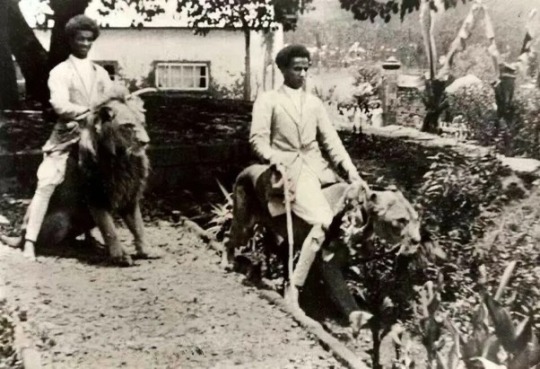
Meet his imperial majesty, the King of the Jungle.
And if, with his thick, shaggy mane Challa seems to have something of a frisky regal air about him - it's because he knows that he is a genuine blue blood.Challa is a direct descendant of Mochuria and Mollua - royal lions, which the late Emperor Haile Selassie kept as pets. The Emperor's practice of keeping pet lions is said to date thousands of years back to the Axumite period.Years ago in Ethiopia, Lions were pets to the people, some were used like donkeys, some like dogs kept at home. Emperor Haile Selassie of Ethiopia had lions he kept as pets, while some Ethiopians could even ride on them. These were not wild lions, they grew up with humans and became domesticated.They didn't go after human blood or other animals, lions roamed around the streets of Ethiopia and live was beautiful with them. Ethiopia is in East Africa, it's a rugged, landlocked country split by the Great Rift Valley, Ethiopia is a place of ancient culture, they believe and still hold on to ancient affairs.
Any lion that goes wild was immediately hunted killed, they were only killed if they kill a human and not animals like goats and chickens. They forbid killing and eating of any lion because lions were pets used in different palaces.
Ethiopia as a country had its origin in about 980 B.C., which makes it one of the oldest nations in the world.
Due to this very long history and an unmatched diversity of people and cultures, the country has often been described as a “museum of peoples”. With such a highly diverse population, Ethiopia houses an intricate tapestry of language and ethnic groups.
Also nicknamed the “Land of 13 Sunshine’s”, Ethiopia is often described as one of the most enthralling and enchanting places in the world – and definitely in Africa.
Ethiopia may not be the first place any traveller think of when planning or booking a next holiday, but it may just as well soon be the case. As African country Ethiopia can boast about having been at peace for at least the previous 15 years or more years and its economy is consequently one of the fastest growing in the world.
With the added bonus of an astounding diversity of landscapes, mixture of cultures and history that tracks back to when homo sapiens first started to raise itself up onto two legs, a traveller suddenly may look forward to a surprising and breath-taking travel destination.
But talking about planning and holiday dated, you probably didn’t know that this unique nation even has its own calendar?
This is but one of a myriad fascinating facts about the country, of which a number are discussed in this article. Looking at the country’s ancient and statutory history, its religion, culture, people and natural phenomena, here are at least 44 random but fascinating facts that you can ponder in anticipation of a visit to this eastern African country in the near future:
Fact number 1 – The oldest people in the world probably lived here.
Fact number 2 – Ethiopia is the oldest independent country in Africa and the only African country that could evade colonial rule.
Fact number 3 – Ethiopia was one of the first African forces to achieve a significant victory over a European colonial power.
Fact number 4 – Ethiopia has a rich history of rulers, including emperors and queens.
Fact number 5 – Ethiopia is perceived to be the diplomatic capital of the African continent
Fact number 6 – Ethiopia is the country with the second highest population in Africa, and with almost 1,5 % of the world population.
Fact number 8 – Ethiopia has the most orphans in the world.
Fact number 10 – Addis Ababa is the highest capital city in Africa.
Fact number 11 – More than 200 dialects are spoken by the peoples of the country.
Please like and share so others can see, drop your comments below and let me know what you think.
98 notes
·
View notes
Text
You have no idea how excited I am that after ages of no non-Joseon sageuks (and barely any sageuks at all), we have three and a half pre-Joseon ones coming that I know of:
Goryeo-Khitan War - coming in November, set in 11th century Goryeo, my most anticipated
Queen Woo - coming next year (is already filming), set in second century Goguryeo, that cast is SICK (and on a shallow note, any drama that gives me Ji Chang Wook, Kim Mu Yeol, and Lee Soo Kyuk in ancient gear with all that gorgeous hair doesn’t even need to go as hard as this one likely will.)
Won Kyung - coming next year, follows the life of Taejong’s queen so straddling the end of Goryeo start of Joseon in the 14th/15th century.
Moon in the Day - the half in my list. It’s going to air in October and follows two star-crossed reborn lovers with apparently a decent chunk of the story taking place in Silla, a kingdom that existed 1st century BCE - 10th century CE (no idea when in particular from that timeline the characters are from.)
Anyway, so so so excited!!!!
(There are also some sageuks that are coming where I don’t know what time period they are in - like Sejak - but with period kdramas until told otherwise, Joseon is always the safest bet.)
60 notes
·
View notes
Text

Two heroes grapple with a foe. The scene is sometimes interpreted as a depiction of Gilgamesh and Enkidu's battle with Humbaba from the Epic of Gilgamesh. Basalt relief sculpture by an unknown artist; 10th century BCE (Neo-Hittite/Hurritic). From Tell Halaf in present-day Syria; now in the Walters Art Museum, Baltimore. Photo credit: Walters Art Museum.
#art#art history#ancient art#Near East#Ancient Near East#Near Eastern art#Ancient Near Eastern art#Gilgamesh#Epic of Gilgamesh#sculpture#relief sculpture#stonework#basalt#carving#Walters Art Museum
392 notes
·
View notes
Text
*in as faithful a translation as possible if translated at all, especially from a dead language you don't speak (e.g. not anne carson's sappho or a modern adaptation of the epic of gilgamesh)
*provided this is an odd way of grouping together date ranges that is partly eurocentric and partly just plain nonsensical since 12 options are the most one can add
75 notes
·
View notes
Text
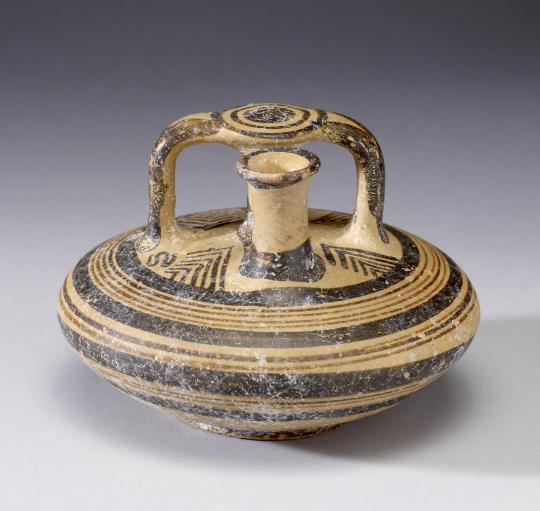
Stirrup Jar with Geometric Decoration
Mycenaean, 14th century BCE (Late Helladic IIIA2)
This jar is named for its handle, which resembles a stirrup. Originally created in Crete in the 16th century BC, the stirrup jar was extremely popular throughout the Aegean region for both storage and transport and became the most characteristic Mycenaean vessel type. The simple decoration looks forward to the Geometric style, which began in 10th-century BC Greece.
45 notes
·
View notes
Text
Science is a rigorous, systematic endeavor that builds and organizes knowledge in the form of testable explanations and predictions about the world.[1][2] Modern science is typically divided into three major branches:[3] the natural sciences (e.g., physics, chemistry, and biology), which study the physical world; the social sciences (e.g., economics, psychology, and sociology), which study individuals and societies;[4][5] and the formal sciences (e.g., logic, mathematics, and theoretical computer science), which study formal systems, governed by axioms and rules.[6][7] There is disagreement whether the formal sciences are science disciplines,[8][9][10] because they do not rely on empirical evidence.[11][9] Applied sciences are disciplines that use scientific knowledge for practical purposes, such as in engineering and medicine.[12][13][14]
The history of science spans the majority of the historical record, with the earliest written records of identifiable predecessors to modern science dating to Bronze Age Egypt and Mesopotamia from around 3000 to 1200 BCE. Their contributions to mathematics, astronomy, and medicine entered and shaped the Greek natural philosophy of classical antiquity, whereby formal attempts were made to provide explanations of events in the physical world based on natural causes, while further advancements, including the introduction of the Hindu–Arabic numeral system, were made during the Golden Age of India.[15]: 12 [16][17][18] Scientific research deteriorated in these regions after the fall of the Western Roman Empire during the early middle ages (400 to 1000 CE), but in the Medieval renaissances (Carolingian Renaissance, Ottonian Renaissance and the Renaissance of the 12th century) scholarship flourished again. Some Greek manuscripts lost in Western Europe were preserved and expanded upon in the Middle East during the Islamic Golden Age[19] and later by the efforts of Byzantine Greek scholars who brought Greek manuscripts from the dying Byzantine Empire to Western Europe in the Renaissance.
The recovery and assimilation of Greek works and Islamic inquiries into Western Europe from the 10th to 13th century revived "natural philosophy",[20][21][22] which was later transformed by the Scientific Revolution that began in the 16th century[23] as new ideas and discoveries departed from previous Greek conceptions and traditions.[24][25] The scientific method soon played a greater role in knowledge creation and it was not until the 19th century that many of the institutional and professional features of science began to take shape,[26][27] along with the changing of "natural philosophy" to "natural science".[28]
New knowledge in science is advanced by research from scientists who are motivated by curiosity about the world and a desire to solve problems.[29][30] Contemporary scientific research is highly collaborative and is usually done by teams in academic and research institutions,[31] government agencies, and companies.[32][33] The practical impact of their work has led to the emergence of science policies that seek to influence the scientific enterprise by prioritizing the ethical and moral development of commercial products, armaments, health care, public infrastructure, and environmental protection.
11 notes
·
View notes
Text
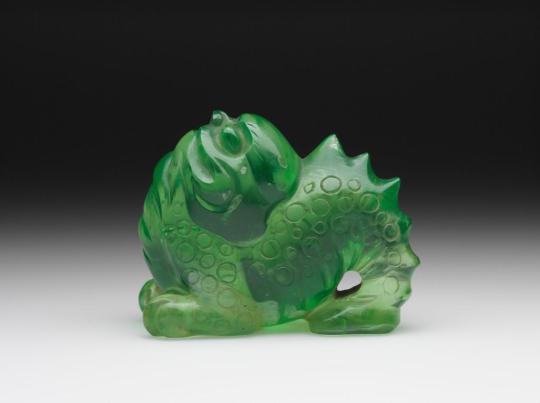
This year, Lunar New Year starts this Saturday, February 10th, and ends Saturday, February 24th.
The traditional Chinese calendar is based on a lunisolar calendar that observes the Sun’s position in the sky and the Moon’s phases, thus also called a lunar calendar. It dates to the 14th century BCE. In addition to China, Lunar New Year is celebrated in South Korea, Vietnam, and other countries with significant overseas Chinese populations.
This is the Year of the Dragon. Dragon is the only mythical creature among the Zodiac animals. It signifies good luck, strength, and power, as well as creativity and charisma. Here’s to an energetic start of the Year of the Dragon!
Dragon. n.d. Transparent lime-green glass. Museum of Fine Arts, Boston; William Sturgis Bigelow Collection. https://jstor.org/stable/community.10662546.
#YearOfTheDragon#LunarNewYear#Dragon#HarvardFineArtsLibrary#FineArtsLibrary#Harvard#HarvardLibrary#DigitalImages
12 notes
·
View notes